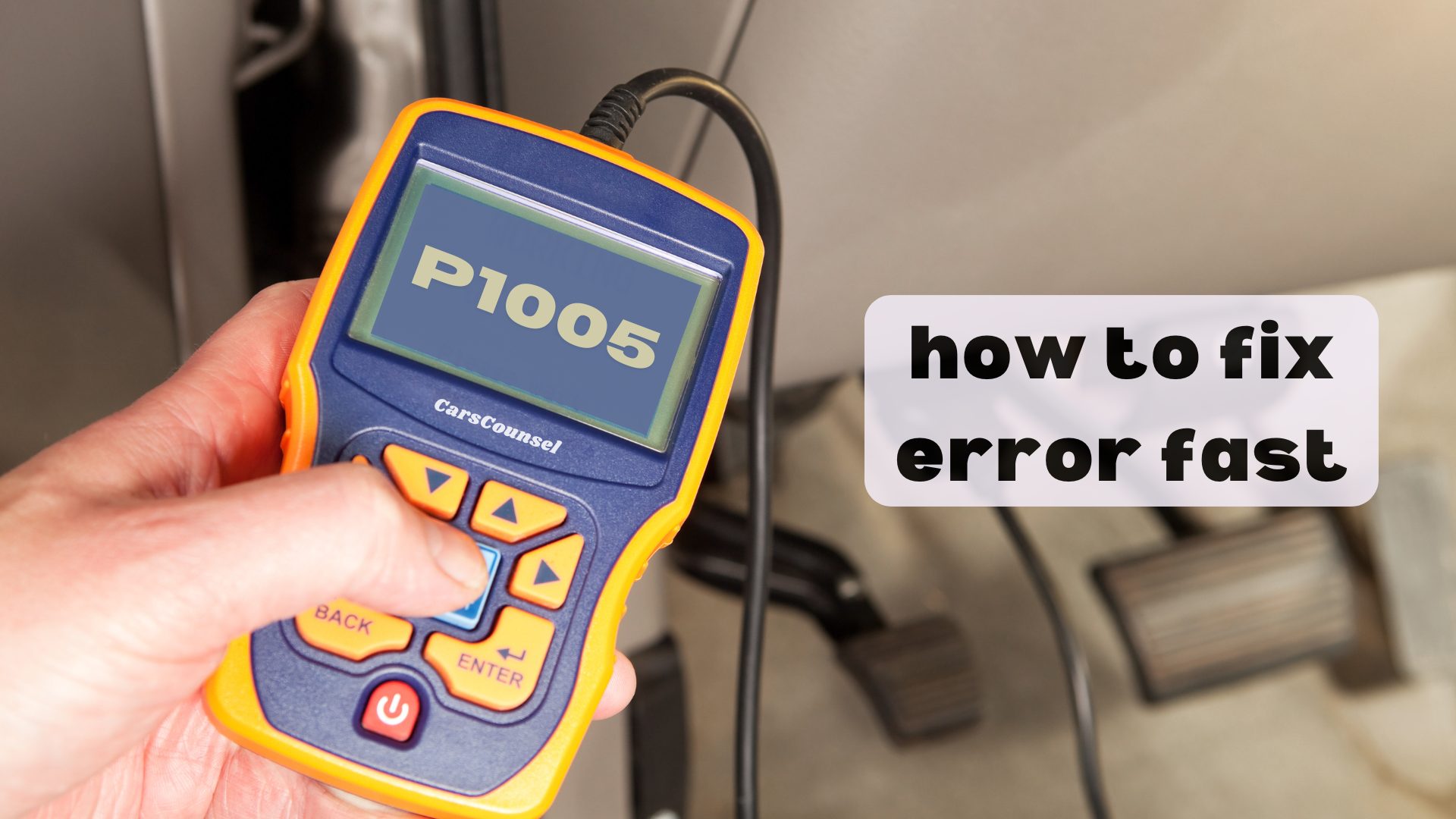Imagine you’re driving your car and suddenly the check engine light comes on, showing a P1005 code on the OBD-II scanner. This error code is related to the Intake Manifold Runner Control (IMRC) system and can be pretty scary.
You might be wondering what went wrong and how to fix it quickly. We’ll walk you through spotting the symptoms, figuring out the root causes, and making the necessary repairs efficiently.
By understanding these key steps, you can reduce downtime and get back on the road with confidence. Let’s dive into how to handle this problem directly.

Quick Navigation
Key Takeaways
- Quickly check and replace any broken IMRC solenoid or actuator parts.
- Use smoke testing to find and fix any vacuum leaks.
- Test the MAP sensor and replace it if it’s giving wrong readings.
- Make sure all wiring connections are solid and fix any damaged or frayed wires.
What Is the P1005 Code?
The P1005 code means there’s a problem with your car’s Intake Manifold Runner Control (IMRC) system, which is important for managing air intake and engine performance.
The intake system controls how much air goes into the engine, affecting how efficiently it burns fuel and how much power it produces. If the IMRC system isn’t working right, it messes up this balance and can make your engine run poorly.
This code usually points to issues with the IMRC solenoid, actuator, or related parts. It’s important to fix this problem quickly because a faulty intake system can lead to bad fuel economy and more emissions.
To find out what’s wrong, you need to check the IMRC parts to make sure they’re working and connected properly, and also look for any blockages or mechanical problems in the intake manifold.
Common Symptoms of P1005
If your car has a P1005 code, you’ll likely notice a rough idle, engine misfires, and less power.
This means your car won’t accelerate as well and will feel weaker overall. You might also see your gas mileage drop because the engine isn’t mixing air and fuel properly, causing it to use more gas.
Another sign of this code is more emissions, and your Check Engine Light might turn on.
If you notice these issues, it’s important to get your car checked out quickly to avoid bigger, more expensive problems later on.
IMRC System Overview
Understanding the Intake Manifold Runner Control (IMRC) system is key to diagnosing and fixing the P1005 code. The IMRC system helps the engine breathe better, which improves performance and saves fuel.
Here’s what it does:
- Maximizing Air Flow: It adjusts valves to let in the most air possible.
- Improving Performance: It makes the engine run better by controlling the air flow.
- Saving Fuel: It makes sure the fuel burns efficiently, which saves gas.
Main Causes of P1005
To fix the P1005 code, you’ll need to look at a few key parts of the IMRC system that might be causing engine problems.
One common issue is a faulty IMRC solenoid, which can mess up airflow control.
Problems with the MAP sensor can give wrong readings of the manifold pressure, making things worse.
Other possible causes include broken IMRC actuators or motors, damaged wiring, or vacuum leaks affecting the manifold pressure.
The throttle body might also be dirty or damaged, adding to the problem.
Lastly, clogged intake manifold runners can restrict airflow.
Finding these issues quickly is important to get your engine running smoothly again.
Diagnosing P1005 Errors
Diagnosing P1005 Errors
To diagnose P1005 errors, start by using an OBD-II scanner to get the code and see if there are any other related codes that might point to more problems.
Then, take a good look at the IMRC system and its parts to see if anything looks damaged or worn out.
Use diagnostic tools to test sensors, especially the MAP sensor, by checking it with a multimeter.
Also, look for vacuum leaks using smoke testing or just by looking closely.
Lastly, check the throttle body to make sure it’s clean and working properly.
- Look for damage in IMRC parts
- Test the MAP sensor with a multimeter
- Check for vacuum leaks using smoke testing
If you’re not experienced with diagnosing car issues, it’s best to consult a professional.
Using an OBD-II Scanner
To diagnose the P1005 error, start by connecting an OBD-II scanner to your car’s diagnostic port to get the specific trouble codes. Knowing the basics of OBD-II is important for accurate troubleshooting.
Once the scanner is connected, it will read and show the codes stored in your car’s computer. Use the scanner’s menu to find the error codes; the P1005 code will show up if there’s a problem with the IMRC. Pay attention to any other codes that appear, as they can give you more information about the issue.
After making repairs, use the scanner to clear the codes to make sure the problem is fixed. Using an OBD-II scanner correctly is key to solving the P1005 code quickly and effectively.
Inspecting IMRC Components
Start by looking at the IMRC parts to see if there’s any noticeable damage or wear. Here are some basic tips for IMRC maintenance and guidelines for replacing parts:
Check the IMRC actuator: Look for any cracks or other damage. If you find any, replace the actuator according to the manufacturer’s instructions.
Look at the IMRC solenoid: Make sure there’s no rust or electrical problems. Replace it if needed.
Inspect the wiring and connectors: Check for any frayed wires or loose connections. Fix or replace them as necessary.
Clean the intake manifold runners: Remove any buildup that might block airflow, using the right cleaning methods.
Checking for Vacuum Leaks
Checking for vacuum leaks means taking a close look at hoses, connections, and seals to see if there’s any wear or damage that could mess with proper manifold pressure.
Start by visually inspecting all vacuum lines and connections for cracks, splits, or loose fittings. Use a vacuum tester to make sure the system keeps the right pressure.
A common way to find leaks is smoke testing. This involves introducing smoke into the vacuum system and looking for any escaping smoke, which would show a leak.
Also, listen for hissing sounds while the engine is running, as these can also indicate a vacuum leak.
Fixing these leaks quickly is important to keep the engine running well and to get rid of the P1005 code.
Fixing P1005 Code Issues
To fix the P1005 code, replace the faulty IMRC solenoid or actuator and install a new MAP sensor if you find it’s giving incorrect readings. Fixing these parts can really boost your engine’s performance.
Additionally, make sure you do the following:
- Repair damaged wiring: Bad connections can mess up IMRC functions.
- Seal or replace vacuum leaks: Keeping the vacuum system tight is crucial for proper manifold pressure.
- Clean or replace the throttle body: Dirt and damage can block airflow, which affects performance.
Preventing Future P1005 Errors
Preventing Future P1005 Errors
Regular checks on your car’s intake and engine parts are key to stopping P1005 errors from happening. By sticking to a routine maintenance schedule, you can ensure that parts like the IMRC system, throttle body, and manifold runners stay in top shape. Regular inspections and cleanings help stop buildup that can cause problems. Also, using good-quality fuel can improve your engine’s performance and lessen the chances of errors. Keep an eye out for early signs of IMRC issues and fix them quickly to make your system last longer.
| Maintenance Task | Frequency | Benefit |
|---|---|---|
| Clean Throttle Body | Every 30,000 miles | Stops buildup |
| Inspect IMRC System | Every 60,000 miles | Ensures it works properly |
| Check Fuel Quality | Ongoing | Improves engine performance |
More OBD-II Codes
Frequently Asked Questions
Can Driving With a P1005 Code Cause Long-Term Damage to the Engine?
Yes, driving with a P1005 code can damage your engine over time. Ignoring warning signs like rough idling and misfires can hurt engine performance and fuel economy. This can lead to higher emissions and expensive repairs.
How Much Does It Typically Cost to Repair a P1005 Code?
Did you know fixing a P1005 code usually costs between $150 and $500? Diagnosing the problem might cost around $100. Prices differ based on parts and labor, so make sure you get a detailed estimate from your mechanic.
Are There Any Temporary Fixes for the P1005 Code Until a Professional Repair Can Be Made?
For a temporary fix, you can try cleaning the throttle body and checking for any vacuum leaks. Make sure all connections are tight. These steps might help for now, but you should still see a professional for a proper repair soon.
What Tools Are Necessary for Diagnosing a P1005 Code at Home?
When you’re trying to figure out a P1005 code at home, you’ll need a few key tools. First, an OBD-II scanner is essential. You’ll also need a multimeter to test sensors and a smoke tester to check for any vacuum leaks. These tools will make the troubleshooting process much easier.
Can a P1005 Code Affect My Car’s Emission Test Results?
Yes, a P1005 code can affect your car’s emission test results. It messes with the air intake, causing higher emissions. Make sure to diagnose and fix the problem to meet emission standards.
Conclusion
To sum it up, fixing the P1005 code quickly means using an OBD-II scanner to confirm the error, checking the IMRC parts, and looking for any vacuum leaks.
Did you know that up to 10% of engine performance issues come from intake manifold problems? By addressing these areas right away and doing regular maintenance, you’ll reduce the chances of seeing the P1005 code again and keep your car running well.
Don’t forget to clear the codes to make sure the fix worked.

